La Boca Formation
The La Boca Formation is a geological formation in Tamaulipas state, northeast Mexico. It was thought to date back to the Early Jurassic, concretely the Pliensbachian stage epoch.[3] Although, the latest studies had proven that the local Vulcanism, related to the aperture of the Atlantic Ocean and the several Rift Events, that continue until the Bajocian, while the unit itself was likely deposited between the earliest Pliensbachian, as proven by zircon (189.0 ± 0.2 Ma) with the fossil taxa deposited on the rocks above, likely of Late Pliensbachian-Lower Toarcian age, and the upper section of Late Toarcian-Late Aalenian age.[4] Due to successions of Aalenian depositional sistems on the upper layers of the Huizachal Canyon, has been delimited the formation to the Toarcian stage, being the regional equivalent of the Moroccan Azilal Formation.[2] Deposits of Late Triassic Age referred to this unit have been reclassified in a new formation, El Alamar Formation.[5] In North America, La Boca Formation was found to be a regional equivalent of the Eagle Mills redbeds of southern United States, the Todos Santos Formation of southern Mexico and the Barracas Group of the Sonora desert region.[6]
| La Boca Formation | |
|---|---|
| Stratigraphic range: Lower Pliensbachian-Latest Aalenian, [1][2] | |
| Type | Geological formation |
| Unit of | Huizachal Group |
| Sub-units |
|
| Underlies | La Joya Formation |
| Overlies | Huizachal Formation |
| Thickness | <10 m |
| Lithology | |
| Primary | Red sandstones, mudstones, and siltstones |
| Other | Pyroclastic volcanic rocks |
| Location | |
| Region | Tamaulipas |
| Country | |
Paleoenvironment
La Boca Formation is genetically related to the Nazas volcanic Arc of the same age (Pliensbachian-Aalenian, ~189.5–171.6 Ma) when Mexico evolved in a convergent plate margin, with the Gulf of Mexico remaining as a restricted basin and a passive margin.[7] The influence of this arcs is seen on the fact continental units such as Todos Santos Formation deposited back then volcanic materials in both nonmarine strata and marginal marine red beds of eastern Mexico. La Boca Formation left its sediments on a basin formed between the Nazas Volcanic Arc center and the so-called Huizachal-Peregrina Anticlinorium, with layers whose origin is linked with channels fills and channel belts filling valleys, as well braided river deposits with different flooding levels.[7] In locations such as Aramberri the development of fluvial channels and the flooding of surfaces was restricted, mostly due to the presence of flanking volcanic activity, as well the local Paleozoic basement highs.[7] In this outcrop the fluvial system evolved on several ways: from braided to ephemeral sandy meandering towards the north, with the presence of common laminated sands sheets, likely a local indicator of unconfined flash floods across floodplains, with some sections recovering periods of desiccation thanks to the presence of Mudcracks. Towards the south, in localities such as El Olmo Canyon the layers show east–west oriented gravelly braided rivers that evolved towards the south of the location into high-sinuosity single-thread meandering rivers.[7] Other southern localities such as the Caballeros Canyon and Huizachal Canyon have layers that record gravel-bed braided rivers over a floodplain with high-energy flows, element recorded on the local stratigraphy as older layers where highly degraded by the increased force of the younger flows and the rock fragments moved by the currents are bigger in upper layers. In the southernmost outcrop, in Miquihuana the sheet sands show greater flooding events than on any other location.[7]
The main fossiliferous level of the Huizachal Canyon with more than 8000 specimens found, where the preservation of delicate specimens such as Pterosaurs suggest an environment with little transportation and reworking, yet the fossils were not buried in situ, as most of the smaller specimens show disarticulation.[8] All data trends suggest a highly unusual debris-flow environment, where local fluvial alluvial bodies were not big enough to sustain large freshwater biota such as fishes and most of the preserved specimens were fast buried near the place of death.[8]
Fossil record
Ichnofossils
| Genus | Species | Location | Material | Type | Made by | Notes | Images |
|---|---|---|---|---|---|---|---|
|
Mermia[7] |
|
|
Locomotion trace |
Domichnia & Fodinichnia |
|
Densely looped grooves or ridges. Taxon linked with the major Early Jurassic flooding of the Huizachal Valley, developed locally mostly on a gravel-bed braided fluvial style with paleocurrents oriented west-northwest |
|
|
|
Burrows |
Domichnia & Fodinichnia |
|
Burrow fossils in lacustrine or fluvial environments, probably made by arthropods |
||
Synapsida
| Genus | Species | Location | Stratigraphic position | Abundance | Notes | Images |
|---|---|---|---|---|---|---|
|
B. tamaulipensis[9] |
Jim's Joy, Huizachal Canyon |
Lower Part |
Teeth |
A basal Mammaliaform[9] |
||
|
B. mexicanum[10] |
Huizachal Canyon |
Lower Part |
IGM 3492, Skull |
 | ||
|
Huasteconodon[9] |
H. wiblei[9] |
Huizachal Canyon |
Lower Part |
Teeth |
||
|
Victoriaconodon[9] |
V. inaequalis[9] |
Rene's Roost, Huizachal Canyon |
Lower Part |
Teeth |
||
|
Unnamed Mammaliaforms (IGM 6622,IGM 6855, and IGM 6856)[9] |
Indeterminate |
|
Lower Part |
IGM 6855, partial right dentary; IGM 6856, left dentary; IGM 6622, partial right dentary |
||
Lepidosauromorpha
| Genus | Species | Location | Stratigraphic position | Abundance | Notes | Images |
|---|---|---|---|---|---|---|
|
T. morenoi |
Dinosaur National Monument South, Huizachal Canyon |
Lower Part |
|
A strange burrowing Lepidosauromorph, probably related with Ardeosauridae. Described originally as a "Burrowing diapsid representing a heretofore unknown clade", was later found to have a compact skull similar to that of Dibamidae and Amphisbaenia by convergent evolution.[13] |
 Example of Dibamidae, that evolved convergently with Tamaulipasaurus | |
Sphenodontia
| Genus | Species | Location | Stratigraphic position | Abundance | Notes | Images |
|---|---|---|---|---|---|---|
|
aff. Clevosaurus sp. |
|
Lower Part |
|
A Sphenodontidae Rhynchocephalian of the family Clevosauridae. |
 | |
|
C. huizachalensis |
Huizachal Canyon |
Lower Part |
|
A Sphenodontidae Rhynchocephalian. Cynosphenodon and Sphenodon share the unique presence of a caniniform tooth.[16] |
||
|
aff. Opisthias sp. |
|
Lower Part |
|
A Sphenodontidae Rhynchocephalian of the family Opisthodontia. |
||
|
S. jimmysjoyi[17] |
Jim's Joy, Huizachal Canyon |
Lower Part |
IGM 6076, an almost complete right lower jaw with teeth |
A possible venomous Sphenodont[17] |
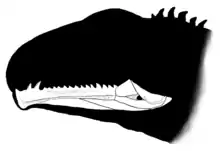 | |
|
Z. ejidoensis |
Tierra Buena, western part of the Huizachal Canyon |
Lower Part |
IGM 3497, crushed skull, missing part of the skull table and roofing bones |
A dwarf Sphenodont |
||
Pterosauria
| Genus | Species | Location | Stratigraphic position | Abundance | Notes | Images |
|---|---|---|---|---|---|---|
|
"D." weintraubi |
Huizachal Canyon |
Lower Part |
Fragmentary skeleton of a large rhamphorhynchoid that includes a remarkably preserved pes. |
A Pterosaur of uncertain phylogenetic placement, being originally proposed as a member of the genus Dimorphodon'", although, has some great differences with the original holotype, and Dimorphodon is a lower Liassic Genus. Most recent analyses place it on different positions on Novialoidea.[20] |
||
Crocodylomorpha
| Genus | Species | Location | Stratigraphic position | Abundance | Notes | Images |
|---|---|---|---|---|---|---|
|
? Metasuchia indeterminate |
Huizachal Canyon |
Lower Part |
IGM 3498 & additional specimens. Partial skulls and postcranial skeletons |
Preliminary results suggest it may be a stem metasuchian.[21] |
||
|
Indeterminate |
Huizachal Canyon |
Lower Part |
Skull fragment |
A possible member of Protosuchia. Found to be sister taxon of Platyognathus hsui from the Lower Jurassic Lufeng Formation of Yunnan.[21] |
||
Dinosauria
| Genus | Species | Location | Stratigraphic position | Abundance | Notes | Images |
|---|---|---|---|---|---|---|
|
Ceratosauria Indeterminate |
Casa de Fidencio, Huizachal Canyon |
Lower Part |
IGM 6625, craneal fragmentary elements |
A possible basal ceratosaur related with the African Berberosaurus. |
||
|
cf.Heterodontosaurus sp. |
Huizachal Canyon |
Lower Part |
Teeth |
An Ornithischian of the family Heterodontosauridae. |
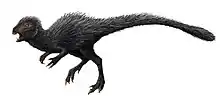 | |
|
"Megapnosaurus" mexicanum [25] |
Casa de Fidencio, Huizachal Canyon |
Lower Part |
(IGM 6624) partial twelfth dorsal vertebra, partial thirteenth dorsal vertebra, partial synsacrum, incomplete fused pelvis |
An indeterminate Coelophysoidean. |
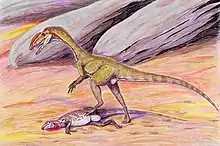 | |
|
Neotheropoda Indeterminate |
Huizachal Canyon |
Lower Part |
Isolated teeth |
Several morphotypes, maybe related with Coelophysoidea, Dilophosauridae or Tetanurae.[23] |
||
|
?Sauropodomorpha indeterminate |
Rene's Roost, Huizachal Canyon |
Lower Part |
Large bone fragments |
A possible Basal Sauropodomorph. |
||
Palynology
| Genus | Species | Location | Stratigraphic position | Material | Notes | Images |
|---|---|---|---|---|---|---|
|
Araucariacites[26] |
|
|
|
Pollen |
A Pollen Grain, affinites with the family Araucariaceae inside Pinales. Conifer pollen from medium to large arboreal plants. |
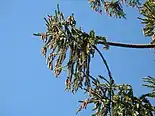 Extant Araucaria. Araucariacites may come from a related plant |
|
Exesipollenites[26] |
|
|
|
Pollen |
A Pollen Grain, affinities with the Hirmeriellaceae in the Pinopsida. |
|
|
Dapcodinium[26] |
|
|
|
Cysts |
A Dinoflajellate of the family Rhaetogonyaulacaceae inside Gonyaulacales |
|
|
|
|
Pollen |
A Pollen Grain, afinnities with Erdtmanithecales inside Spermatophytes. |
||
|
Exesipollenites[26] |
|
|
|
Pollen |
A Pollen Grain, affinities with the family Cupressaceae in the Pinopsida. Pollen that resembles that of extant genera such as the genus Actinostrobus and Austrocedrus, probably derived from dry environments. |
 |
|
Dictyophillidites[26] |
|
|
|
Spores |
A Miospore, affinities with Dipteridaceae inside Filicopsida |
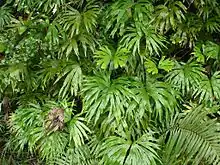 Extant Dipteris, typical example of Selaginellaceae. Dictyophillidites probably come from a similar or a related Plant |
|
Krausellisporites[26] |
|
|
|
Spores |
A Miospore, affinities with Selaginellaceae or Lycopodiaceae inside Lycopsida. |
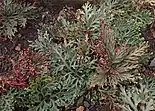 Extant Selaginella, typical example of Selaginellaceae. Krausellisporites probably come from a similar or a related Plant |
|
Nannoceratopsis[26] |
|
|
|
Cysts |
A Dinoflajellate of the family Nannoceratopsiaceae inside Nannoceratopsiales |
|
|
Ovalipollis[26] |
|
|
|
Pollen |
A Pollen Grain, afinnities with Caytoniales inside Gymnospermopsida. |
|
|
Pareodinia[26] |
|
|
|
Cysts |
A Dinoflajellate of the family Pareodinioideae inside Gonyaulacales |
|
|
Quadraeculina[26] |
|
|
|
Pollen |
A Pollen Grain, affinities with Podocarpaceae and Pinaceae inside Coniferophyta. |
|
|
Rhaetogonyaulax[26] |
|
|
|
Cysts |
A Dinoflajellate of the family Peridiniphycidae inside Dinophyceae |
|
|
Spheripollenites[26] |
|
|
|
Pollen |
A Pollen Grain, affinities with the Hirmeriellaceae in the Pinopsida. |
|
|
Vitreisporites[26] |
|
|
|
Pollen |
A Pollen Grain, afinnities with Caytoniales inside Gymnospermopsida. |
|
Macroflora
| Genus | Species | Location | Stratigraphic position | Material | Notes | Images |
|---|---|---|---|---|---|---|
|
|
|
|
Affinities with Cheirolepidiaceae or Araucariaceae inside Pinales. Includes petrified wood logs up to 3.5 m in size |
||
|
|
|
|
Affinities with Cheirolepidiaceae inside Pinales. |
||
|
|
|
|
Affinities with Cupressaceae inside Pinales. |
||
|
|
|
|
Affinities with Cycadeoidaceae inside Bennettitales. |
||
|
|
|
|
Affinities with Williamsoniaceae inside Bennettitales. Representative of large arboreal to low arbustive Bennetittes. The dominant foliar remain recovered on the formation, with up to 50 specimens |
||
|
Laurozamites[30] |
|
|
|
|
Affinities with Williamsoniaceae inside Bennettitales. Representative of large arboreal to low arbustive Bennetittes. The dominant foliar remain recovered on the formation, with up to 50 specimens |
|
|
|
|
|
Affinities with Williamsoniaceae inside Bennettitales. |
||
|
|
|
|
Affinities with Matoniaceae inside Gleicheniales. |
||
|
|
|
|
Affinities with Krassiloviaceae inside Voltziales. |
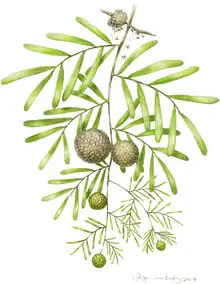 Podozamites reconstruction | |
See also
References
- Rubio-Cisneros, I. I.; Lawton, T. F. (2011). "Detrital zircon U-Pb ages of sandstones in continental red beds at Valle de Huizachal, Tamaulipas, NE Mexico: Record of Early-Middle Jurassic arc volcanism and transition to crustal extension". Geosphere. 7 (1): 159–170. Bibcode:2011Geosp...7..159R. doi:10.1130/GES00567.1.
- Martini, M.; Ortega-Gutiérrez, F. (2018). "Tectono-stratigraphic evolution of eastern Mexico during the break-up of Pangea: A review". Earth-Science Reviews. 183 (3): 38–55. Bibcode:2018ESRv..183...38M. doi:10.1016/j.earscirev.2016.06.013. S2CID 132691866. Retrieved 2 April 2022.
- Bartolini, Claudio; Wilson, James Lee; Lawton, Timothy Frost (1999). Mesozoic Sedimentary and Tectonic History of North-central Mexico (2 ed.). Texas: Geological Society of America. p. 221. ISBN 9780813723402. Retrieved 2 April 2022.
- Boschman, L.; Van Hinsbergen, D. J.; Langereis, C. G.; Molina-Garza, R. S.; Kimbrough, D. L. (2017). "Paleomagnetic Constraints on the Tectonic History of the Mesozoic Ophiolite and Arc Terranes of Western Mexico". AGU Fall Meeting Abstracts. 2 (2): 345. Bibcode:2017AGUFM.T22B..05B. Retrieved 2 April 2022.
- Barboza-Gudiño, J. R; Zavala-Monsiváis, A.; Venegas-Rodríguez, G.; Barajas-Nigoche, L. D. (2010). "Late Triassic stratigraphy and facies from northeastern Mexico: Tectonic setting and provenance". Geosphere. 6 (5): 621–640. doi:10.1130/GES00545.1. Retrieved 20 April 2023.
- Mixon, R. B.; Murray, G. E.; Teodoro, D. G. (1959). "Age and Correlation of Huizachal Group (Mesozoic), State of Tamaulipas, Mexico". ADDENDUM. AAPG Bulletin. 43 (4): 757–771. Retrieved 2 April 2022.
- Cisneros, I. I. R.; Holbrook, J. (2021). "Fluvial interpretations of stratigraphic surfaces across Upper Triassic to Lower-Middle Jurassic continental red beds northeastern Mexico". Journal of South American Earth Sciences. 110 (2): 103366. Bibcode:2021JSAES.11003366R. doi:10.1016/j.jsames.2021.103366. Retrieved 2 April 2022.
- Fastovsky, D. E.; Clark, J. M.; Strater, N. H.; Montellano, M.; Hopson, J. A. (1995). "Depositional environments of a Middle Jurassic terrestrial vertebrate assemblage, Huizachal Canyon, Mexico". Journal of Vertebrate Paleontology. 15 (3): 561–575. doi:10.1080/02724634.1995.10011249. Retrieved 2 April 2022.
- Montellano, M.; Hopson, J. A.; Clark, J. M. (2008). "Late Early Jurassic mammaliaforms from Huizachal Canyon, Tamaulipas, México" (PDF). Journal of Vertebrate Paleontology. 28 (4): 1130–1143. doi:10.1671/0272-4634-28.4.1130. S2CID 128782275. Retrieved 2 April 2022.
- Fraser, Nicholas; Sues, Hans-Dieter, eds. (1994). In the Shadow of the Dinosaurs: Early Mesozoic Tetrapods. Cambridge University Press. ISBN 0-521-45242-2.
- Clark, J.M.; Hopson, J. A. (1985). "Distinctive mammal-like reptile from Mexico and its bearing on the phylogeny of the Tritylodontidae". Nature. 315 (8): 398–400. Bibcode:1985Natur.315..398C. doi:10.1038/315398a0. S2CID 4280605. Retrieved 2 April 2022.
- Clark, J. M. (1994). "A new burrowing diapsid from the Jurassic La Boca Formation of Tamaulipas, Mexico". Journal of Vertebrate Paleontology. 14 (2): 180–195. doi:10.1080/02724634.1994.10011551. Retrieved 2 April 2022.
- Reynoso, V. H.; Cruz, J. A.; Rivera-Sylva, H. E.; Carpenter, K.; Frey, E. (2014). "Mesozoic lepidosauromorphs of Mexico: a review and discussion of taxonomic assignments". Dinosaurs and Other Reptiles from the Mesozoic of Mexico. 2 (1): 4–44. Retrieved 3 April 2022.
- Reynosa, V. (1992). "Descripcion de los esfenodontes del Jurasico temprano 0 medio de Canon Huizachal, Tamaulipas, Mexico". Unpublished M.Sc. Thesis, Instituto de Geologia, Universidad Nacional Autonoma de Mexico, Mexico City, Mexico. Retrieved 2 April 2022.
- Reynoso, V. H. (1996). "A Middle Jurassic Sphenodon-like sphenodontian (Diapsida: Lepidosauria) from Huizachal Canyon, Tamaulipas, Mexico". Journal of Vertebrate Paleontology. 16 (2): 210–221. doi:10.1080/02724634.1996.10011309. Retrieved 2 April 2022.
- Reynoso, V. H. (2003). "Growth patterns and ontogenetic variation of the teeth and jaws of the Middle Jurassic sphenodontian Cynosphenodon huizachalensis (Reptilia: Rhynchocephalia)". Canadian Journal of Earth Sciences. 40 (4): 609–619. Bibcode:2003CaJES..40..609R. doi:10.1139/e02-097. Retrieved 2 April 2022.
- Reynoso, V.H. (2005). "Possible evidence of a venom apparatus in a Middle Jurassic sphenodontian from the Huizachal red beds of Tamaulipas, Mexico". Journal of Vertebrate Paleontology. 25 (2): 646–653. doi:10.1671/0272-4634(2005)025[0646:PEOAVA]2.0.CO;2. S2CID 131602253. Retrieved 2 April 2022.
- Reynoso, V.H.; Clark, J.M. (1998). "A dwarf sphenodontian from the Jurassic La Boca Formation of Tamaulipas, Mexico". Journal of Vertebrate Paleontology. 18 (3): 333–339. doi:10.1080/02724634.1998.10011061. Retrieved 2 April 2022.
- Clark, J. M.; Hopson, J. A.; Fastovsky, D. E.; Montellano, M. (1998). "Foot posture in a primitive pterosaur". Nature. 391 (6670): 886–889. Bibcode:1998Natur.391..886C. doi:10.1038/36092. S2CID 4408637. Retrieved 2 April 2022.
- Britt, B. B.; Dalla Vecchia, F. M.; Chure, D. J.; Engelmann, G. F.; Whiting, M. F.; Scheetz, R. D. (2018). "Caelestiventus hanseni gen. et sp. nov. extends the desert-dwelling pterosaur record back 65 million years" (PDF). Nature Ecology & Evolution. 2 (9): 1386–1392. doi:10.1038/s41559-018-0627-y. PMID 30104753. S2CID 51984440. Retrieved 2 April 2022.
- Stiegler, J.; Hernández-Rivera, R.; Clark, James M. (2020). "Two Small Crocodyliformes from the Middle Jurassic La Boca Formation of Tamaulipas, Mexico". The Society of Vertebrate Paleontology 80th Annual Meeting · Virtual 2020. 80 (1): 32.
- Reynoso, V.H. (2006). "Research on fossil amphibians and reptiles in Mexico, from 1869 to early 2004 (including marine forms but excluding pterosaurs, dinosaurs, and obviously, birds)". In F. J. Vega, T. G. Nyborg, M. Del Carmen Perrilliat, M. Montellano-Ballesteros, S. R. S. Cevallos-Ferriz, S. A. Quiroz-Barroso (Eds.), Studies on Mexican Paleontology. 24 (7): 209–231. Retrieved 2 April 2022.
- Munter, R. C.; Clark, J. M. (2006). "Theropod dinosaurs from the Early Jurassic of Huizachal Canyon, Mexico". In M. T. Carrano, T. J. Gaudin, R. W. Blob, J. R. Wible (Eds.), Amniote Paleobiology: Perspectives on the Evolution of Mammals, Birds, and Reptiles. University of Chicago Press, Chicago. 2 (4): 53–57. ISBN 9780226094786. Retrieved 2 April 2022.
- Clark, James; Montellano, Marisol; Hopson, James A.; Hernandez, Rene; Fastovsky, David A. (1994). "An Early or Middle Jurassic tetrapod assemblage from the La Boca Formation, northeastern Mexico". In Fraser, N.C.; Sues H.-D. (eds.). In The Shadow of the Dinosaurs: Early Mesozoic Tetrapods. Cambridge: Cambridge University Press. pp. 295–302. ISBN 0-521-45899-4.
- González González, A. H.; De Stefano Farías, A. (2002). "Fósiles de México- Coahuila: Una ventana a través del tiempo. Gobierno del Estado de Coahuila". Fossiles de Mexico (1): 214–215. Retrieved 2 April 2022.
- Rueda –Gaxiola, J. (2010). "Application of glauconite and fossil palynomorphs in reconstructing the Liassic paleogeography just before the opening of the Gulf of Mexico (Part I)" (PDF). Iranian Journal of Earth Sciences. 2 (1): 107–124. Retrieved 26 July 2023.
- Silva, Jorge (2017). "La tipología escalar como base de la correlación de la Aloformación La Boca y La Cuarcítica Cualac del anticlinorio de Huizachal-Peregrina, Tamaulipas con los grupos Consuelo y Tecocoyunca del anticlinorio de Tlaxiaco". Tesis de Licenciatura IPN. 11 (1): 55. Retrieved 20 April 2023.
- Silva-Pineda, A.; Buitrón-Sánchez, B. E.; Bartolini, C. (1999). "Mesozoic red bed floras in east-central Mexico and their stratigraphic relationships with marine beds". Geological Society of America. 340 (5): 151–160. Retrieved 2 April 2022.
- Eguiluz-de Antuñano, S.; Aranda-García, M.; Buitrón-Sánchez, B. E. (2014). "Las formaciones Gran Tesoro y Nazas: evolución de las secuencias Triásico Superior-Jurásico Inferior en México y su significado tectogenético". Boletín de la Sociedad Geológica Mexicana. 66 (3): 507–539. doi:10.18268/BSGM2014v66n3a8.
- Weber, R. (1997). "How old is the Triassic flora of Sonora and Tamaulipas and news on Leonardian floras in Puebla and Hidalgo, Mexico" (PDF). Revista Mexicana de Ciencias Geológicas. 14 (2): 225–243.